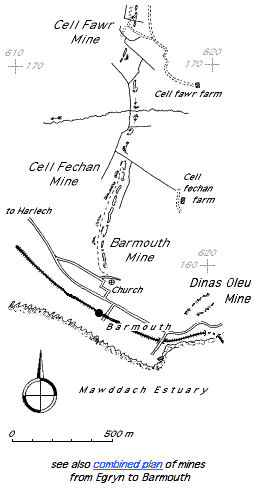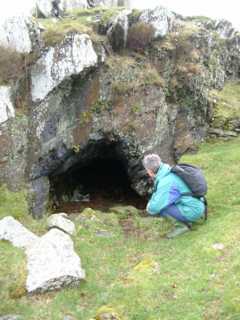Cell Fechan
| Location | SH614164 (Area map showing location.) | ||||||||||||||||||||||||||||||||||||||||||||||||
|---|---|---|---|---|---|---|---|---|---|---|---|---|---|---|---|---|---|---|---|---|---|---|---|---|---|---|---|---|---|---|---|---|---|---|---|---|---|---|---|---|---|---|---|---|---|---|---|---|---|
| Parish | Llanaber | ||||||||||||||||||||||||||||||||||||||||||||||||
| Geology | The ore bed is about .25 m thick, is interbedded with Harlech grits and imediately underlain by a 50mm bed of shaly sandstone containing numerous large cubes of iron pyrites. The whole series dips east at about 70°. The ore consists mostly of carbonate of manganese with hydrated black oxide coating it where exposed to the weather. Associated with the ore are many veins of quartz which sometimes contain copper pyrites. Large botryoidal lumps of manganese also occur. [Dewey & Bromehead 1915: 51] | ||||||||||||||||||||||||||||||||||||||||||||||||
| Owners |
|
||||||||||||||||||||||||||||||||||||||||||||||||
| Agents |
|
||||||||||||||||||||||||||||||||||||||||||||||||
| Production and Employment |
|
||||||||||||||||||||||||||||||||||||||||||||||||
| Transport | There is a network of tracks cut into the slope or on stone embankments which possibly served the workings. | ||||||||||||||||||||||||||||||||||||||||||||||||
| Remains | A series of shallow depressions and grassed-over waste tips with two underground workings at SH615167. The workings continue northwards across a ravine (with stream) as Cell Fechan mine and southwards as Barmouth mine. (December 2001) | ||||||||||||||||||||||||||||||||||||||||||||||||
| There are remains of a leat at SH617167 associated with a boggy depression SH618167 which may be the site of an old reservoir. However, it is not known if this was associated with the mine. | |||||||||||||||||||||||||||||||||||||||||||||||||

The advertisement for the 1899 sale by auction of the estate of John Abraham Esq., deceased, includes the text:
There is a valuable vein of manganese on the estate, which has been proved, and there is a ready sale for the same at a profitable price, and gold veins have also been opened.
Dewey & Bromehead [1915: 51], reporting on Cell Fechan and Hafotty about this time, describe the mines as “abandoned” with the levels flooded and overgrown but with a good deal of ore remaining. (The flooded levels probably refer to Hafotty as no flooded levels are apparent on this site.)
There is mention of manganese being raised at Cell Fechan in 1917. [Barmouth and County Advertiser 22/3/1917 p. 2]
In 1918 it was reported that Barmouth Urban Council had received an offer by a mining engineer “to raise manganese on Cell Fechan Farm”. [Cambrian News 24/5/1918 p. 8]
